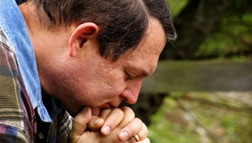Acts 2:42 is a summary statement of the first few weeks of the aftermath of Pentecost. “And they continued steadfastly in the apostles’ doctrine and fellowship, in the breaking of bread, and in prayers” (KJV). I now move on to the fourth item, prayers. This can be understood in two ways, as some translations use the term “and the prayers,” that is, ritualistic or commonly repeated prayers.
 First, we can take it as it reads in the KJV. There is no question that the original twelve disciples knew what it meant to pray. Take, for example, the passage where they asked Jesus, “Lord, teach us to pray” (Luke 11:1). He immediately answered, “When you pray, say…” and gave them what the Church calls the Lord’s Prayer but is better called the Disciples’ Prayer.
First, we can take it as it reads in the KJV. There is no question that the original twelve disciples knew what it meant to pray. Take, for example, the passage where they asked Jesus, “Lord, teach us to pray” (Luke 11:1). He immediately answered, “When you pray, say…” and gave them what the Church calls the Lord’s Prayer but is better called the Disciples’ Prayer.
In the same chapter Luke records the promise of prayer, “And I tell you, ask, and it will be given to you; seek, and you will find; knock, and it will be opened to you. For everyone who asks receives, and the one who seeks finds, and to the one who knocks it will be opened” (verse 9,10). What comfort this triple assurance of answered prayer gives us!
On numerous occasions, Jesus plainly said to his disciples, “Pray!” He himself spent time alone with God in prayer, so the example and exhortation to pray was constantly present. Jesus also taught how not to pray. In Matthew’s account of the Luke 11 incident, we read, “And when you pray, you must not be like the hypocrites. For they love to stand and pray in the synagogues and at the street corners, that they may be seen by others. Truly, I say to you, they have received their reward… And when you pray, do not heap up empty phrases as the Gentiles do, for they think that they will be heard for their many words” (Matthew 6:5,7). I’m reminded of D.L. Moody who had asked a man in a service to pray, and he prayed around the world a couple of times. While he was still praying, Moody got to his feet and said, “While our brother is finishing his prayer we’ll sing the closing hymn!” I’ve heard plenty of those kinds of prayer.
So the disciples were taught to pray, but whether they grasped the importance of it we don’t know (Jesus did say they were slow on the uptake!). Also remember this verse is not just about the 11 remaining original disciples but the 3,000 who were added to the church (Acts 2:41) after Peter’s sermon on the Day of Pentecost. Apart from that sermon in these early chapters of the Acts, we don’t have much record of what was included in “the apostles’ doctrine” (verse 42). Yet some kind of praying was observed.
The issue is further complicated when we remember this was truly a Jewish Pentecost and the participants were of the Jewish faith (Acts 2:5). Even the apostles were still keeping the Jewish traditions, as was evident by Peter and John going up to the temple at the hour of prayer (Acts 3:1). The modern example of this period might be the charismatic movement in the mainline denominations in the early 1960s. These Christians discovered a far greater depth of experience in their knowledge of the Holy Spirit and spoke in other languages as in Acts 2:4, yet initially they still went to their denominational churches and were comfortable with their ritual. Later many were given the left foot of fellowship and sent on their way when they persisted in the experience.
Translations with the definite article “the” (which is in the Greek but doesn’t always match the English grammar) include ASV 1901, ESV, GNB, and Wuest who renders it, “to the gatherings where prayers to God were offered,” which is a good explanatory paraphrase. So it is just as likely in context that the “prayers” were communal prayers that had been repeated for centuries in the Jewish religion, or even the Disciples’ Prayer that Jesus had taught the Twelve.
All I can say is that prayer is important. “Continue steadfastly in prayer, being watchful in it with thanksgiving” (Colossians 4:2), and as I have often declared, “If you are having trouble with prayer, talk to God about it!”



Leave A Comment